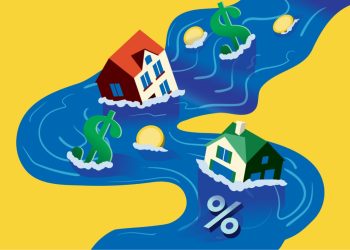 The U.S. Department of Housing and Urban Development (HUD) and the U.S. Department of the Treasury today released the February edition of the Obama Administration’s Housing Scorecard—a comprehensive report on the nation’s housing market. Data continues to show signs that the housing market is strengthening, although the recovery remains fragile. The supply of new and existing homes on the market continued to decline last month. However, home prices dipped again as seasonal lows continued for the fourth month in a row. The continued fragility of the housing market underscores the need for recently-announced expansions of assistance to help prevent foreclosures and strengthen hard hit communities. The full Housing Scorecard is available online at www.hud.gov/scorecard.
The U.S. Department of Housing and Urban Development (HUD) and the U.S. Department of the Treasury today released the February edition of the Obama Administration’s Housing Scorecard—a comprehensive report on the nation’s housing market. Data continues to show signs that the housing market is strengthening, although the recovery remains fragile. The supply of new and existing homes on the market continued to decline last month. However, home prices dipped again as seasonal lows continued for the fourth month in a row. The continued fragility of the housing market underscores the need for recently-announced expansions of assistance to help prevent foreclosures and strengthen hard hit communities. The full Housing Scorecard is available online at www.hud.gov/scorecard.
“Since April 2009, more than 13 million homeowners have taken advantage of our refinance programs. Following enhancements to the Home Affordable Refinance Program, another 300,000 families have already started the process of refinancing and stand to save on average $2,500 per year—the equivalent of a good-sized tax cut. So the Administration’s efforts have produced significant positive benefits,” says HUD Assistant Secretary Raphael Bostic. “But 1 in 5 Americans still owes more than their home is worth. This lasting scar of the Great Recession driven by housing’s collapse is a clear sign that we are not yet out of the woods. That is why we are asking the Congress to approve the President’s housing proposals so that more homeowners can receive assistance.”
Included in this month’s Making Home Affordable Program Report are detailed assessments for the largest mortgage servicers participating in the program with results from the fourth quarter of 2011. The Servicer Assessments—first introduced in June 2011 and published quarterly—have set a benchmark for disclosure around servicer efforts to assist struggling homeowners.
“The Making Home Affordable Program has established critical standards that have changed the mortgage industry for the better, and the assessments have been a principal tool for measuring that progress,” says Treasury Assistant Secretary for Financial Stability Tim Massad. “By shining the spotlight on key practices, we have prompted servicers to improve their implementation of the Making Home Affordable Program. However, there is still more work to be done to ensure that the industry treats all borrowers properly. The implementation of the broader standards required by the settlement, together with our continued compliance efforts, will help bring this about.”
The standards established by the Making Home Affordable Program were also a guide for many of the servicing standards included in the historic $25 billion settlement recently announced between the federal government, 49 state Attorneys General and the five largest mortgage servicers regarding mortgage servicing and foreclosure deficiencies.
Since inception of the Making Home Affordable Program, Treasury has required participating servicers to take specific actions to improve their processes through ongoing program reviews. The latest Servicer Assessments summarize performance on metrics in three categories of program implementation: identifying and contacting homeowners; homeowner evaluation and assistance; and program reporting, management and governance. Results for the fourth quarter of 2011 show that servicers are focusing attention on areas identified in previous program reviews and, as a result, are demonstrating considerable improvement in program implementation:
• Mortgage servicers show continued improvement in calculating homeowner income, which is used to determine a homeowner’s eligibility and modified payment amount under the program.
• Servicers are more effectively evaluating homeowners under program eligibility criteria as performance in the “second look disagree” category, which reflects the rate at which Treasury’s program reviews disagree with the servicers’ decision not to assist a homeowner, remains consistently below the established benchmark.
As the Administration continues to push servicers to provide more effective assistance to struggling homeowners, the ongoing recovery of the housing market demonstrates the need for the Administration’s efforts. The February Housing Scorecard features key data on the health of the housing market and the impact of the Administration’s foreclosure prevention programs, including:
• Market data show progress on housing overhang and sales but continued fragility in home prices. The supply of homes on the market continued to decline last month. At the current rate, it would take 6.1 months to turn over the supply of existing homes currently on the market – and just 5.6 months to turn over the stock of new homes for sale – the lowest inventory of homes for sale since 2006. Existing home sales continued to improve this month, reaching their highest pace since May 2010. However, home prices dipped again in December, as measured by the Case-Shiller index, as seasonal lows continued for the fourth month.
• The Administration’s foreclosure programs are providing relief for millions of homeowners as we continue to recover from an unprecedented housing crisis. More than 5.7 million modification arrangements were started between April 2009 and the end of January 2012 – including nearly 1.8 million trial modification starts through the Home Affordable Modification Program (HAMP) and more than 1.2 million FHA loss mitigation and early delinquency interventions. The Administration’s programs continue to encourage improved standards and processes in the industry, with HOPE Now lenders offering families and individuals more than 2.7 million proprietary mortgage modifications through January.
• Homeowners entering HAMP demonstrate a high likelihood of long-term success in the program. As of January, more than 950,000 homeowners received a permanent HAMP modification, saving more than $530 on their mortgage payments each month. Eighty-five percent of homeowners entering the program in the last 19 months have received a permanent modification, with an average trial period of 3.5 months. Homeowners in HAMP permanent modifications have saved an estimated $11 billion to date. View the January Making Home Affordable Program Performance Report.
For more information, visit www.treasury.gov.










